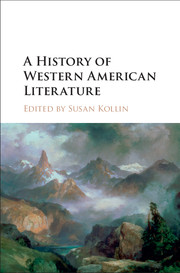Book contents
- Frontmatter
- Contents
- Notes on Contributors
- Acknowledgments
- Introduction: Historicizing the American Literary West
- PART I HOMELANDS
- PART II MAKING A REGION
- PART III GEOGRAPHIES OF THE LITERARY WEST
- 8 Literature of the Great Plains: Nature, Culture, and Community
- 9 Southwest Literary Borderlands
- 10 Imagining the Rocky Mountain Region
- 11 Writing the Pacific Northwest
- 12 The Far North: Literatures of Alaska and Canada
- 13 The Problem of the Critical in Global Wests
- PART IV THE TWENTIETH CENTURY AND BEYOND: LITERARY MOVEMENTS AND CRITICAL PERSPECTIVES
- Selected Bibliography
- Index
8 - Literature of the Great Plains: Nature, Culture, and Community
from PART III - GEOGRAPHIES OF THE LITERARY WEST
Published online by Cambridge University Press: 05 November 2015
- Frontmatter
- Contents
- Notes on Contributors
- Acknowledgments
- Introduction: Historicizing the American Literary West
- PART I HOMELANDS
- PART II MAKING A REGION
- PART III GEOGRAPHIES OF THE LITERARY WEST
- 8 Literature of the Great Plains: Nature, Culture, and Community
- 9 Southwest Literary Borderlands
- 10 Imagining the Rocky Mountain Region
- 11 Writing the Pacific Northwest
- 12 The Far North: Literatures of Alaska and Canada
- 13 The Problem of the Critical in Global Wests
- PART IV THE TWENTIETH CENTURY AND BEYOND: LITERARY MOVEMENTS AND CRITICAL PERSPECTIVES
- Selected Bibliography
- Index
Summary
Late in Wright Morris's spare, hard-edged novel Plains Song: For Female Voices (1980), Sharon Rose Atkins leaves her comfortable New England life to visit her former home on the Nebraska plains. In a car driven by a blunt talking niece, Sharon leaves the city of Lincoln and watches as the countryside blurs by. Along the way, her niece Caroline peppers her with “brash” questions and opinions about family history, female independence, and domestic oppression. Heat and sun overcome Caroline's forays with soporific effect, lulling Sharon into reverie. “The wires dipped and rose,” Morris tells us; “the poles and trees flickered past, and in the fabric of fancy, like a patterned design, she sensed something both lost and something gained.” Sharon's family had homesteaded in this rolling country, and Caroline with her car full of children conceivably represents the leading edge of future life on this landscape, something gained. Yet when Caroline pulls off the road and takes her aunt to a place of “tall weeds … tree stumps torn out by their roots … [and] deep pits,” Sharon looks over an unrecognizable plot, a yard that resembles “craters left by bombs.” She wonders, “Why had they stopped?” Surveying the farmscape of her childhood, Sharon draws a blank. Nothing remains – no houses, no barns, no gardens, no windbreaks. “‘Nobody wanted it,’ Caroline explains. ‘There was nothing worth saving.’” The past, tangibly, irrevocably, is lost, and Sharon realizes this wasted battlefield is where her life began.
Morris economically captures, in this scene, a central collision point in Great Plains literature: the slippage between past and future marked in present spaces. Traces of violence, conquest, and unrealized desire lie buried like tectonic plates, surface erasure tracing something more menacing beneath. Plains Song connects to the longer literary tradition of Great Plains writing, borne out of a vexed history of contact, national expansion, and settlement. Across regions, centuries, cultures, genres, and traditions, Great Plains writers in the last two centuries have reckoned with ephemerality and loss, displacement and escape, the hope of new beginnings and the collapse of dreams.
- Type
- Chapter
- Information
- A History of Western American Literature , pp. 129 - 144Publisher: Cambridge University PressPrint publication year: 2015

